Guimarães might not be on the top of your Portugal bucket list, but it’s a great day trip from Porto and the historic city is known as the birthplace of Portugal.

Why Guimarães?
Guimarães is a small city about a 45 minute drive or bus ride (75 minutes by train) from Porto. The city is very important to Portuguese national identity as it symbolizes the birth of the country.
In 1128 CE, Portugal was in crisis. Theresa of León laid claim to the throne. Even though she was Portuguese, Theresa was unpopular in her home country due to her romantic dalliance with Spanish nobility (Spain was Portugal’s enemy). So, the people rallied behind Theresa’s son, Afonso Henriques.
Afonso’s armies defeated Theresa’s forces in the Battle of São Mamede near Guimarães. Spain was defeated, Portugal was united, and Afonso became the first king of Portugal.

The people of Guimarães are rightfully proud of their city’s history and there’s a large sign in the middle of town saying “Aqui nasceu Portugal” or Portugal was born here.
But, there’s much more to Guimarães than Medieval history (though there’s plenty of that). There’s also hilltop views with trails for hiking, a delicious pastry named after the city, and Vinho Verde wine to drink in local bars. Here’s 5 great things to do in Guimarães.
1. Take a funicular for amazing views
The highest point in Guimarães is Mount Penha (Serra da Penha) aka Monte de Santa Catarina.
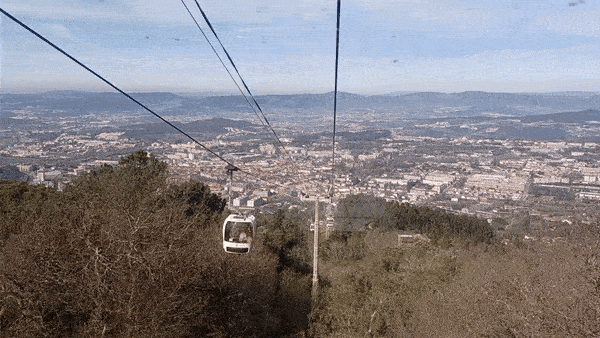
All of this area, including Guimarães is on a bed of granite. Mount Penha has lots and lots of rocky outcroppings that form interesting patterns. Apparently, Bronze Age humans used these rocks for shelter and pagan celebrations over 5,000 years ago.
Of course, since this is Portugal, they built a church on top of this mountain. In fact, they built a few.
The biggest (and least interesting) is the Penha Sanctuary. Built in the mid 1900’s, it’s more functional than beautiful. But, it does have one big thing going for it. Behind the church is a gorgeous miradouro (viewpoint). From the Miradouro Penha you can see into the valley below and the entire city of Guimarães as well as the mountains behind it. And, on a clear day, you can see all the way to the ocean (25 miles).

Even though this lookout is the top attraction on the mountain, there’s lots more to see. 150 acres of green space covers the peak with lots of hiking hilly hiking trails.
There’s a cool bar, Adega do Ermintao, not far from the Penha Sanctuary. Part of it is under a rock formation, making it seem like you’re sipping your beer at the mouth of a cave.
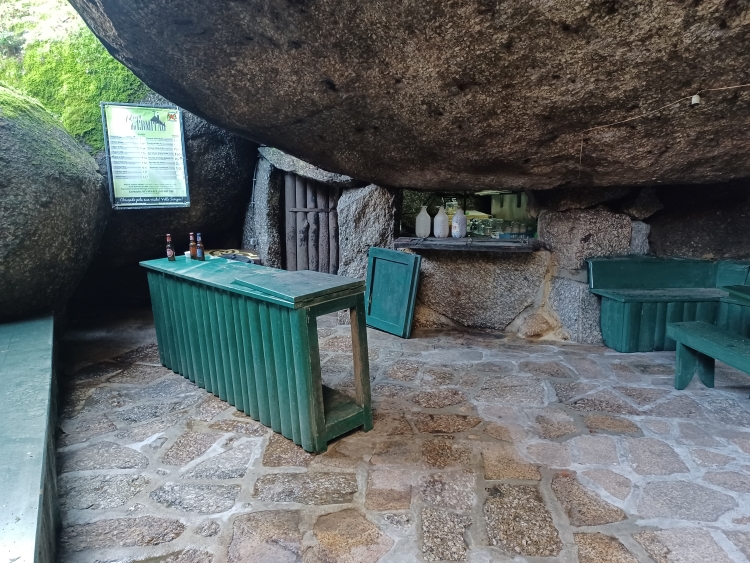
Speaking of caves, the Gruta de Nossa Senhora do Carmo is a small chapel carved from a gap between the rocks. Originally used by the hermit Guilherme Marino, today the chapel is open to anyone who stumbles upon this site dedicated to Saint Elias, Patron Saint of Sleep.

Climb some more granite stairs to the Chapel of São Cristóvão (Chapel of St. Christopher) and you’ll be rewarded with what might be even better views than Miradouro Penha (and far fewer crowds).
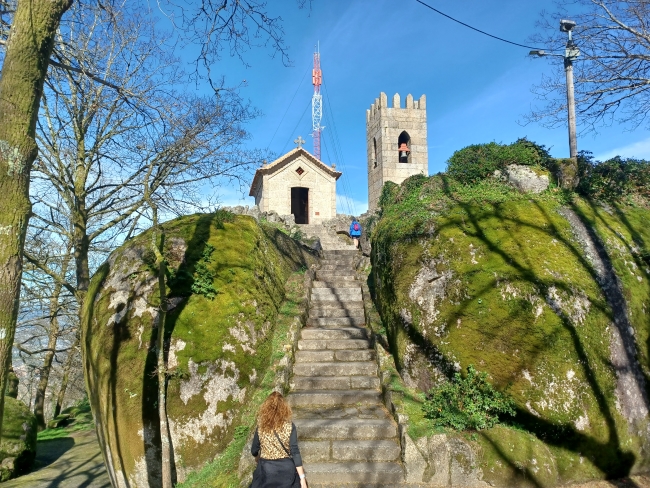
If you want stay overnight, there’s camping on Mount Penha as well as the Grove Houses.
Getting to Mount Penha
You could walk up the mountain from Guimarães, but it would be quite the hike, maybe 90 minutes, much of it pretty strenuous.
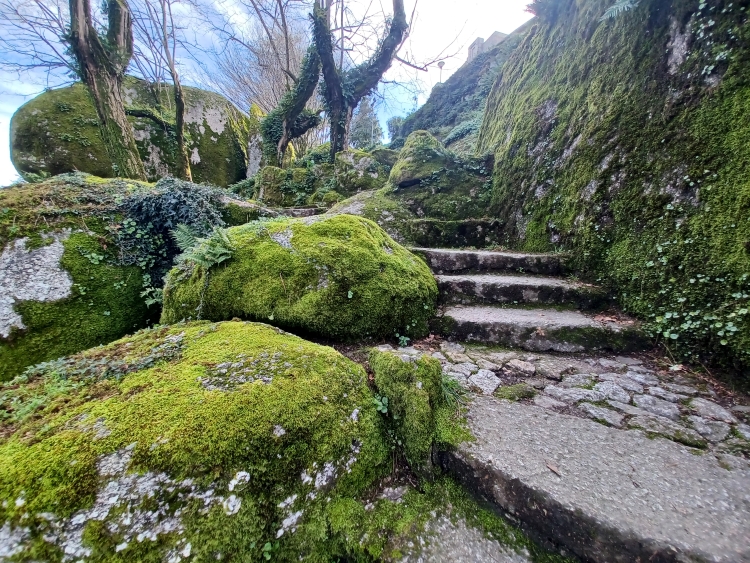
Luckily, there’s an easier, and much more scenic way.
The Teleférico de Guimarães (Penha Cable Car) is a funicular that zips you to the top of the mountain in less than 10 minutes. The views going up (and down) are spectacular, as well.
Be aware that if you have a fear of heights or vertigo this might not be for you. But, you can always skip the funicular and take a car or rideshare, there’s parking up top.
Also, if you have mobility issues, there are lots of blocky granite stairs and some unsure footing on the mountain. Be forewarned.
2. Taste the delicious pastry named for Guimarães
Every city, town, and village in Portugal, it seems, has its own specialty pastry. Searching them out as you travel is a fun and sweet activity.

Many of these unique pastries originated in the convents and monasteries of Portugal. Nuns would often make and sell these treats as a way to supplement the meager income generated by offerings.
The Convento de Santa Clara de Guimarães (Convent of St. Clare) was built in 1548. When the convents and monasteries were abolished by a new Portuguese government in 1834, the nuns who were living there were allowed to remain until they died. In 1891, the last nun at Santa Clara passed away and the building was abandoned. In 1968, the building became the Guimarães city hall, a function it still serves today.
While the nuns were active in Santa Clara, they invented the recipe for Tortas de Guimarães. A flaky puff pastry is filled a jam of egg yolks, sugar, ground almonds, and squash. The dough is folded to make a crescent shape and crimped along the edges.
The pastry is then baked and then, while still hot, dipped in simple syrup, making the dough crispy and crunchy.
Now, if sweetened squash doesn’t sound like something you’d enjoy, you’ll have to trust me. It’s quite delicious.

The other famous pastry in town is the Toucinho de ceu de Guimaraes. It also originated at the Convento de Santa Clara. And, it’s not hard to see why.
The nuns used the same filling of egg yolks, sugar, ground almonds, and squash. Then, after the mixture is formed, it is coated in flour and baked. After the Toucinho is removed from the oven and allowed to cool, it is sprinkled with powdered sugar.

Any bakery in Guimarães will likely have Tortas de Guimarães and most have the Toucinho de Ceu as well. My favorite is Clarinha, right off Largo do Toural. It’s a classic Portuguese bakery with a great selection of sweets and their Tortas de Guimarães is fantastic.
Padaria das Trinas is another excellent bakery in Guimarães. They’ve been around since 1881 and do a great business.
3. Wander the former leather-making district (and find a characteristic bar)
For over 100 years, during the 19th and the first half of the 20th centuries, the economy of Guimarães was powered by the leather industry. In what is known as the Zona de Couros or Leather Zone, several leather factories churned out textiles made of cow skin.
The last factory closed in 2005, but there is a museum called the Curtir Ciência Centro Ciência Viva de Guimarães that is housed in a former factory. The museum is mainly aimed at children, but adults interested in the leather industry will find it interesting as well.
Also in the neighborhood are abandoned stone vats where the cow skin was soaked in water treated with oak bark to make it workable. You can also see an old water mill that was used to bring the water used in the process.

The Zona de Couros is a hidden gem of a neighborhood with cobblestone streets and residential homes punctuated by an occasional cafe or bar.
This is where we stumbled upon Taberna Corta. Don’t look for it on TripAdvisor or even Google Maps. This local’s place doesn’t seem to have any Internet presence whatsoever. What it does have is loads of charm.

Ask for a glass of wine and it might be served in a teacup. Here’s their address, but don’t tell anyone, I want it to be our secret.
4. Visit a Medieval Castle
Because Guimarães lies so far north, it was an early part of the Reconquista, the centuries’ long military campaigns that expelled Muslims from the Iberian Peninsula.
Shortly after Guimarães was liberated in the 10th century, construction began on the Guimarães Castle. Situated on a hill, the castle afforded a strategic point to help defend the city from further Muslim or Norse invasions. There isn’t much from this original castle, but recent archeological work has uncovered some of the original pieces.
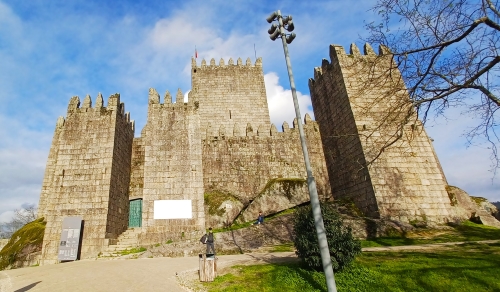
While the original 10th century castle was designed in the Romanesque style, much of the current castle was reconstructed in the Gothic style.
Legend has it that Portugal’s first king, Afonso Henriques, was born in the early 12th century in Guimarães (though scholars debate this) and was baptized in the São Miguel do Castelo, a church very close to the castle, although this is also up for debate.
In the 17th century, the castle fell into ruin, so much so that in 1836, the government of Guimarães wanted to demolish the castle and use the stone to repave city roads. Luckily, that plan was never executed and in 1910 the castle was declared a national monument. Much work has been completed since then to preserve the castle.
As of this writing, the castle is currently under renovation and not open to visitors.
While there, you can also visit the Palace of the Dukes of Braganza, a 15th century noble residence that is now a museum.
5. Learn about why an olive tree is so important
Sometimes you visit historical site not for what actually happened there, but for the legend surrounding the place. Igreja de Nossa Senhora da Oliveira is one such place.
Don’t get me wrong, the church itself is pretty interesting with an imposing Medieval façade and interior filled with gilded carvings. But it is the legend of Our Lady of Oliveira that is truly fascinating.
The story goes that a Visigoth king in the 7th century said, after a military victory, that he would plunge his sword into the ground and if an olive tree sprouted he would build a church there. (other versions have him putting an olive twig in the ground)
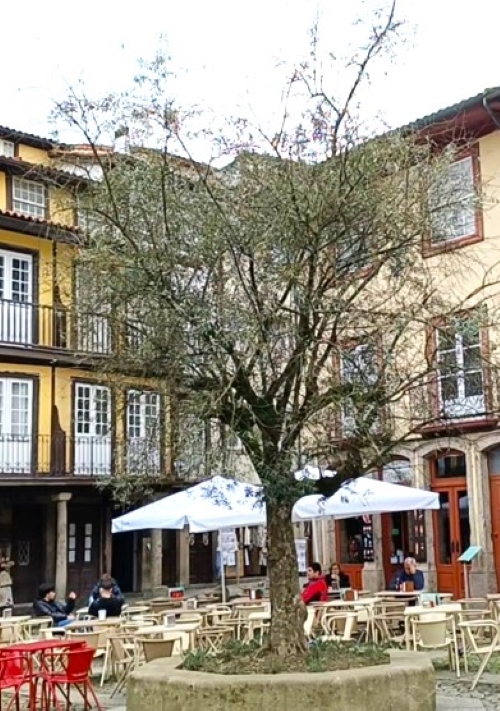
Of course the olive tree sprouted and a church was built.
Another variation of the story is that the Goth king brought an olive branch from the Garden of Olives in Jerusalem. That tree, unfortunately, did not survive. However, when a cross was placed next to it in 1342, the tree sprouted.
That tree remained in the square next to the church until about 1870 (over 500 years!). The olive tree that’s in the square today occupies the same spot as that original tree and was planted about 40 years ago and right next to Padrão do Salado, an interesting Medieval monument commemorating the Portuguese victory in the Battle of Rio Salado against Sultan Abu al-Hasan ‘Ali.

The square is lined with cafes and a bakery. It’s fun to sit on the square and imagine plunging your sword into the ground 1,400 years ago, declaring that a church shall be built on the site.
About the Author

Brent Petersen is the Editor-in-Chief of Destination Eat Drink. He currently resides in Setubal, Portugal. Brent has written the novel “Truffle Hunt” (Eckhartz Press) and the short story collection “That Bird.” He’s also written dozens of foodie travel guides to cities around the world on Destination Eat Drink, including in-depth eating and drinking guides in Portugal to Lisbon, Porto, Sintra, Á‰vora, Braga, Loulé, Almada, Monsaraz, and Batalha. Brent’s podcast, also called Destination Eat Drink, is available on all major podcasting platforms.
